Introduction
Discover the ultimate guide to choosing the best fertilizers for your kitchen garden. Whether you’re a beginner or a seasoned gardener, understanding how to nourish your vegetables and herbs with the right nutrients is key to a thriving garden. This comprehensive article explores a variety of fertilizer options—organic and synthetic—tailored for small-scale kitchen gardening. Learn about essential nutrients like nitrogen, phosphorus, and potassium, and how they affect plant health and productivity. We also discuss the pros and cons of different fertilizer types, including compost, manure, liquid feeds, granular blends, and slow-release options. You’ll find practical tips on when and how to apply fertilizers to maximize plant growth without overfeeding or harming the environment. With helpful product recommendations and eco-friendly practices, this blog is designed to make home gardening more fruitful, sustainable, and rewarding. Whether you’re growing tomatoes, mint, spinach, or chilies, the right fertilizer can make all the difference. Boost your harvest, enhance soil health, and enjoy homegrown produce like never before. Read on to transform your kitchen garden into a nutrient-rich oasis using simple and effective fertilizing techniques. Perfect for urban gardeners, backyard growers, and anyone aiming for a greener, healthier lifestyle.
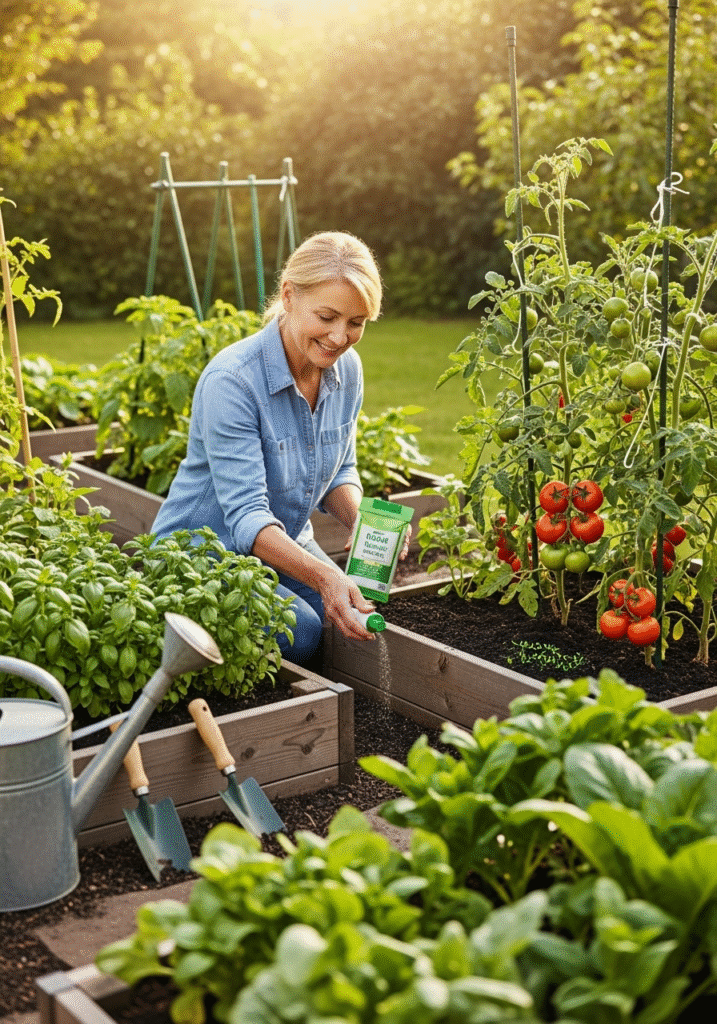
Why Fertilizers Are Essential for a Kitchen Garden
Fertilizers play a critical role in the success of any kitchen garden, no matter how small or large. Over time, the soil in your garden naturally loses nutrients, especially when vegetables and herbs are continuously harvested from the same space. This depletion can lead to poor plant performance if not properly addressed. Fertilizers act as a nutritional supplement for the soil, replenishing essential elements that plants need to grow strong, healthy, and productive. The three primary nutrients provided by most fertilizers are nitrogen (N), phosphorus (P), and potassium (K)—commonly referred to as the NPK trio. Nitrogen promotes leafy growth, phosphorus supports root development and flower production, while potassium improves overall plant health and resistance to disease. When these nutrients are lacking, plants may show signs such as yellowing leaves, stunted growth, weak stems, and a lack of flowers or fruits. These symptoms not only affect the aesthetic appeal of your garden but also dramatically reduce your yield. Whether you’re growing leafy greens like spinach, flowering vegetables like tomatoes, or root crops like carrots, the right fertilizer ensures they receive the nourishment needed at every stage of growth. In short, fertilizing is not just a task—it’s an essential part of maintaining a vibrant and productive kitchen garden that yields fresh, nutritious food for your home.
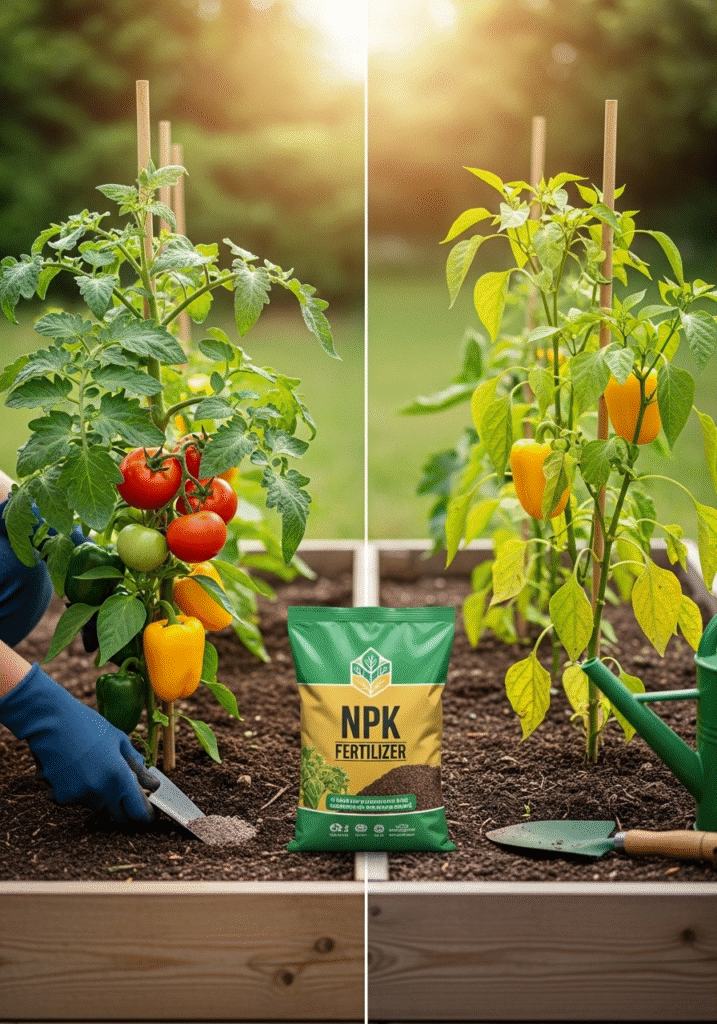
Types of Fertilizers
Understanding the different types of fertilizers is crucial for anyone aiming to maintain a healthy, high-yielding kitchen garden. Fertilizers are broadly categorized into two main types: organic and chemical (synthetic), each with its unique advantages and considerations.
Organic fertilizers are derived from natural sources such as compost, well-rotted animal manure, bone meal, seaweed extracts, and plant-based residues. These fertilizers not only supply essential nutrients like nitrogen, phosphorus, and potassium, but also improve the overall soil structure. They enhance microbial activity in the soil, promote better moisture retention, and gradually release nutrients over time, which reduces the risk of over-fertilization. Organic fertilizers are especially beneficial for long-term soil health and sustainability, making them a favorite choice among eco-conscious home gardeners.
Chemical or synthetic fertilizers, on the other hand, are manufactured using industrial processes and provide nutrients in a more concentrated and readily available form. They are designed to deliver specific nutrient ratios (often labeled as NPK values) and offer quick results, making them ideal for correcting nutrient deficiencies rapidly. However, these fertilizers should be applied with care, as overuse can lead to nutrient buildup in the soil, harm beneficial microbes, or even damage plants. Proper application techniques and timing are essential to maximize benefits while minimizing environmental impact.
Choosing between organic and chemical fertilizers—or using a balanced combination of both—depends on your gardening goals, soil condition, and the specific needs of your plants. Understanding these options allows you to make informed decisions that support both plant health and soil vitality in your kitchen garden.
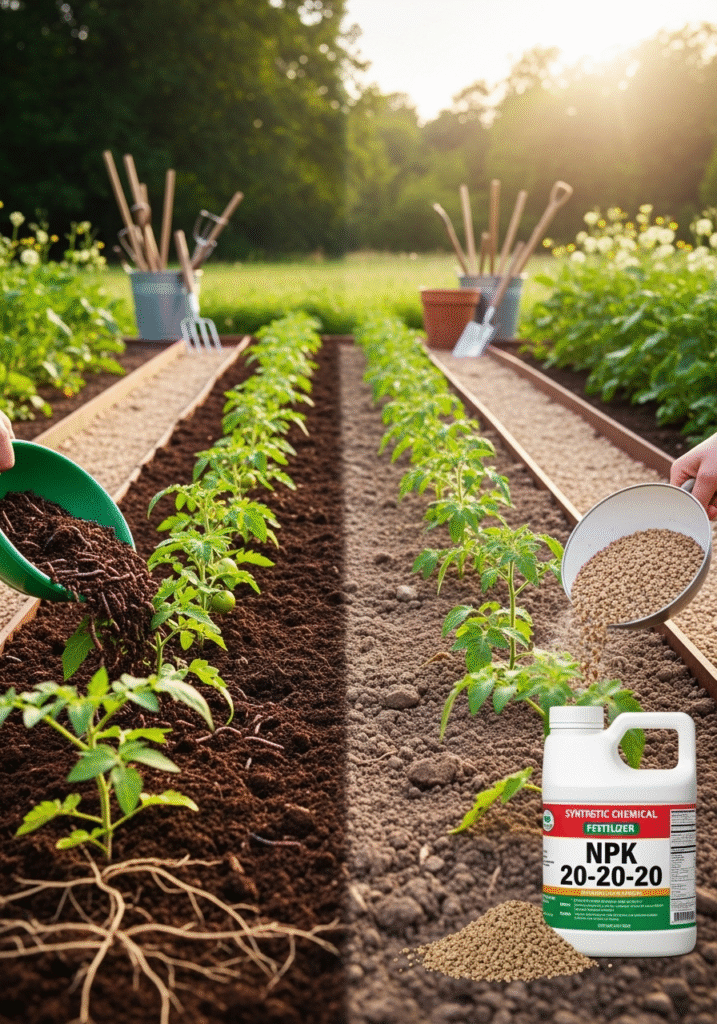
Top Organic Fertilizers for Kitchen Gardens
Organic fertilizers are the backbone of a healthy, sustainable kitchen garden. Unlike chemical fertilizers, they nourish plants while enriching the soil, promoting microbial activity, and improving the garden’s long-term productivity. In this section, we highlight the top organic fertilizers that every home gardener should consider using for lush, thriving vegetables and herbs.
1. Compost:
Compost is one of the most versatile and essential organic fertilizers. Created by decomposing kitchen scraps, dried leaves, and biodegradable waste, compost not only feeds plants but also transforms the soil structure. It improves aeration, enhances water retention, and provides a broad spectrum of nutrients that plants need to flourish. Suitable for all kitchen garden crops, compost is easy to make at home and can be used throughout the growing season.
2. Vermicompost:
Produced with the help of earthworms, vermicompost is a nutrient-rich organic fertilizer packed with beneficial microbes and enzymes. It strengthens plant immunity, improves soil aeration, and boosts root development. Especially effective for leafy greens and herbs, vermicompost can be applied near the plant base every few weeks for continuous nourishment.
3. Cow Dung Manure:
A traditional and time-tested soil conditioner, well-rotted cow dung is loaded with organic matter and slow-releasing nutrients. It enhances soil fertility and supports healthy microbial activity. Cow dung manure is best suited for fruiting plants like tomatoes and chilies, and it should be incorporated into the soil during planting for optimal results.
4. Bone Meal:
Bone meal is made from finely ground animal bones and is a rich source of phosphorus and calcium. These nutrients are vital for strong root systems and prolific flowering. Ideal for root vegetables and flowering plants, bone meal supports early plant establishment and can be mixed directly into the soil at planting time or used as a top dressing during the growing phase.
5. Fish Emulsion:
Fish emulsion is a fast-acting, liquid organic fertilizer made from processed fish waste. It provides a quick boost of nitrogen and other nutrients, making it perfect for fast-growing vegetables. Easy to use as a diluted foliar spray, fish emulsion promotes vibrant growth and can be applied every two weeks for visible results.
6. Seaweed Extract:
Seaweed is packed with micronutrients, trace elements, and natural growth hormones that promote overall plant vigor. Seaweed extract enhances nutrient uptake, stimulates root and shoot growth, and improves resistance to stress and disease. It is particularly useful for herbs, cucumbers, and tomatoes, and can be applied as a foliar spray or soil drench every few weeks.
7. Neem Cake:
Neem cake is a powerful organic fertilizer and natural pest deterrent. A byproduct of neem oil production, it enriches the soil with essential nutrients while protecting plant roots from harmful nematodes and insects. Neem cake is effective for nearly all vegetable crops, particularly those prone to pest infestations, and should be mixed into the soil before planting.
Each of these organic fertilizers brings unique benefits to your kitchen garden. When used in combination or as part of a rotating schedule, they not only increase crop yield but also create a healthy, fertile, and pest-resistant environment for your plants to thrive in.
For a garden that blooms all year round, follow our Seasonal Flower Planting Guide to choose the right flowers for every season.
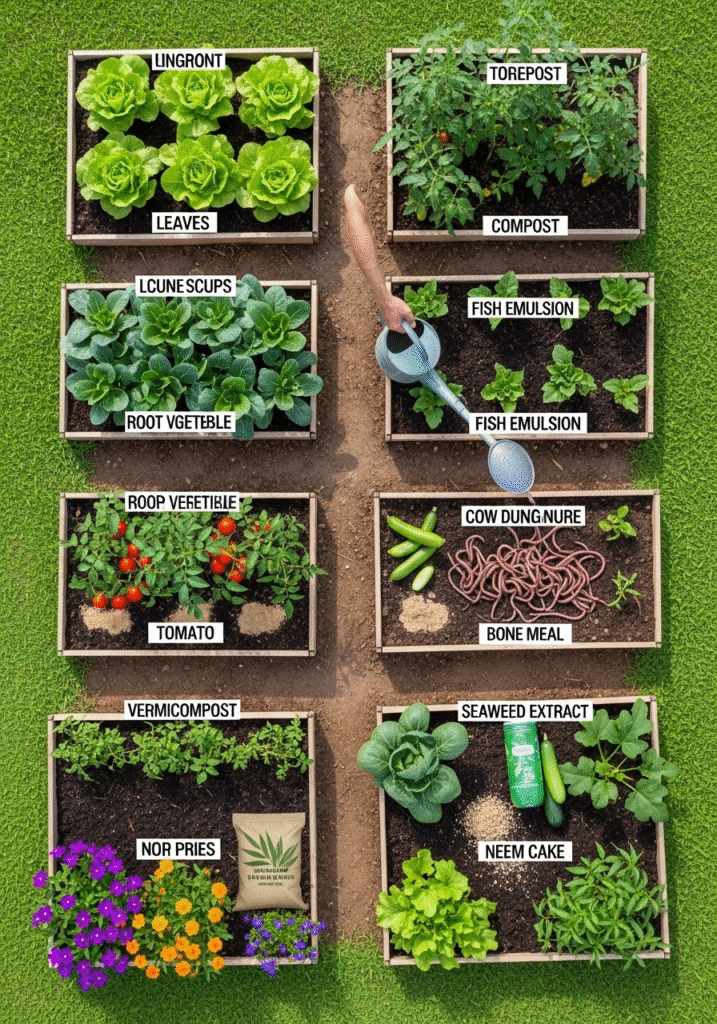
Top Chemical Fertilizers for Kitchen Gardens
While organic fertilizers are ideal for sustainable gardening, chemical (synthetic) fertilizers can offer a fast and targeted nutrient boost—especially when plants show signs of nutrient deficiency or during critical growth phases. In a kitchen garden, where space is often limited and productivity is key, chemical fertilizers can be used in small, controlled doses to enhance yield and plant health. However, they must be applied with caution to avoid over-fertilization, root burn, or environmental harm. Below are some of the most effective chemical fertilizers for home gardeners and how to use them wisely:
1. NPK Fertilizer (e.g., 10-10-10 or 19-19-19):
NPK fertilizers are balanced blends containing the three primary macronutrients—Nitrogen (N) for leafy growth, Phosphorus (P) for root and flower development, and Potassium (K) for overall plant health. These formulations are excellent all-purpose fertilizers suitable for a wide variety of kitchen garden vegetables. For best results, dissolve the recommended amount in water and apply it around the plant base every 15–20 days. Always water the plants afterward to prevent nutrient burn.
2. Urea (46% Nitrogen):
Urea is a highly concentrated source of nitrogen, making it an excellent choice for promoting lush green foliage. It is particularly effective for leafy vegetables like spinach, coriander, fenugreek, and lettuce. Due to its strength, urea should be used sparingly—typically 1–2 grams per liter of water—and applied during the early growth stage. Avoid overuse, as excessive nitrogen can lead to weak stems and delay flowering.
3. DAP (Diammonium Phosphate):
DAP is a powerful fertilizer containing both nitrogen and phosphorus, essential for early plant development. It encourages strong root growth and robust shoot formation. This makes it ideal for use during the sowing or transplanting stage of vegetables. DAP granules should be applied into the soil but kept at a safe distance from seeds to prevent germination issues or root damage.
4. Micronutrient Mixes:
While macronutrients are crucial, plants also require trace elements like zinc, iron, manganese, boron, and copper for balanced growth. Micronutrient deficiencies often go unnoticed until growth becomes stunted or leaves show discoloration. A micronutrient mix, available in powder or liquid form, can correct these imbalances effectively. Most are used as foliar sprays—simply mix with water according to the manufacturer’s instructions and spray directly on the leaves every few weeks. These are especially helpful in areas with nutrient-poor or sandy soil.
By incorporating chemical fertilizers wisely and in moderation, home gardeners can enhance plant performance, support healthy development, and enjoy more abundant harvests. It’s important to remember that chemical fertilizers are supplements, not replacements for healthy soil. Combining them with organic compost or manure often produces the best long-term results in a kitchen garden.
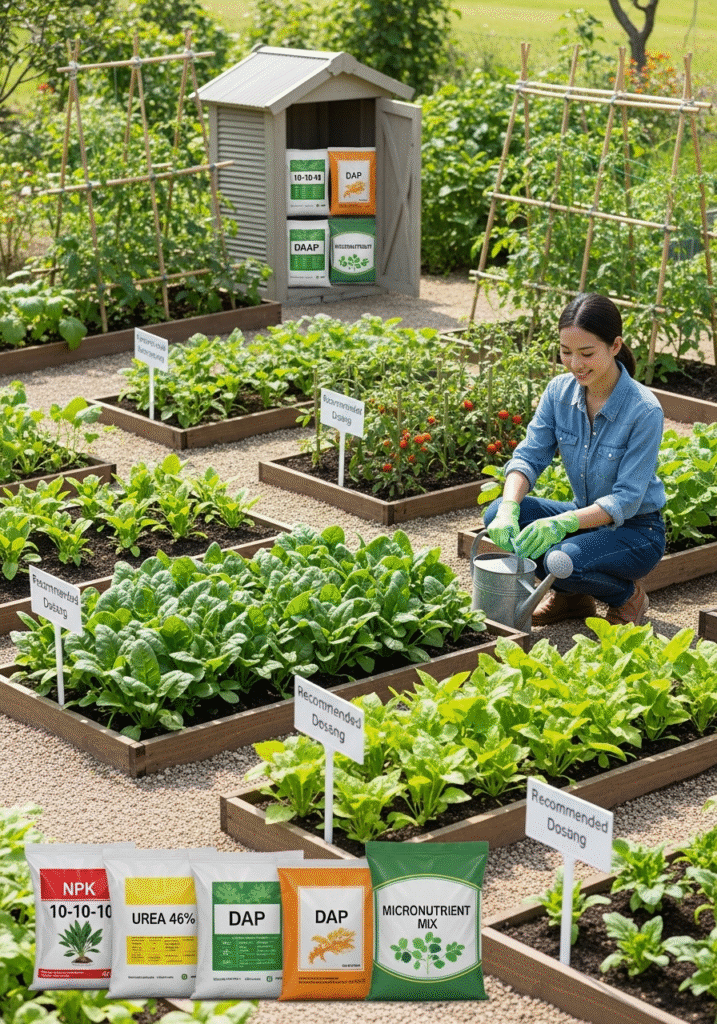
Best Fertilizers for Common Kitchen Garden Plants
Different kitchen garden plants have unique nutritional requirements, depending on their growth habits, harvest cycles, and sensitivity to soil conditions. Using the right type of fertilizer for each plant not only boosts productivity but also improves flavor, color, and disease resistance. Whether you’re growing leafy greens, fruiting vegetables, or fragrant herbs, a targeted fertilization plan can make a significant difference. Below is a detailed guide to the best fertilizer combinations for commonly grown kitchen garden plants:
Tomatoes:
Tomatoes are heavy feeders that require a balanced diet throughout their growing cycle. Start with a mix of compost to enrich soil texture, and bone meal to boost phosphorus for strong root and flower development. During the vegetative and early flowering stages, supplement with NPK 19-19-19 for a balanced nutrient supply. Once flowers appear, apply a dose of fish emulsion every 2 weeks to encourage fruit development and improve overall plant vigor. Consistent feeding results in plump, juicy tomatoes with vibrant color and flavor.
Spinach and Leafy Greens:
Leafy vegetables like spinach, lettuce, and fenugreek thrive on nitrogen-rich fertilizers. Begin by applying well-aged compost to improve soil structure and moisture retention. To boost green, leafy growth, use urea in small amounts or apply vermicompost near the root zone every couple of weeks. Avoid high-phosphorus fertilizers, as they can suppress leaf development and lead to imbalanced growth. Regular feeding ensures lush, tender leaves that are full of nutrients.
Chillies and Peppers:
Fruiting vegetables like chillies and peppers need a steady supply of organic and inorganic nutrients. Start with cow dung manure to condition the soil, followed by moderate doses of NPK fertilizer to support root development and fruit formation. As the plants begin to flower and fruit, spray with liquid seaweed extract every 2–3 weeks. Seaweed contains growth hormones and trace minerals that enhance flowering and boost fruit quality, making your chillies spicier and your peppers more colorful and productive.
Herbs (Mint, Basil, Coriander):
Herbs are delicate and aromatic, and they prefer lighter, organic nourishment. Overfeeding with synthetic fertilizers can reduce their essential oil content and aroma. The best approach is to apply compost regularly to maintain soil fertility and use neem cake to keep the roots healthy and pest-free. Neem cake acts as both a fertilizer and a natural pesticide, making it ideal for herbs grown in containers or small plots. This combination promotes lush, fragrant growth while preserving the herbs’ medicinal and culinary qualities.
Cucumbers and Gourds (e.g., Bottle Gourd, Bitter Gourd):
These vining plants need both root and shoot support due to their fast growth and heavy fruiting. Use a mix of compost and vermicompost to enrich the soil at planting time. Apply liquid seaweed extract regularly during the flowering stage to improve pollination and fruit set. Additionally, DAP (Diammonium Phosphate) can be used early in the season to promote strong root growth and vine development. This feeding strategy helps cucumbers and gourds grow faster, resist disease, and produce higher yields with improved taste and texture.
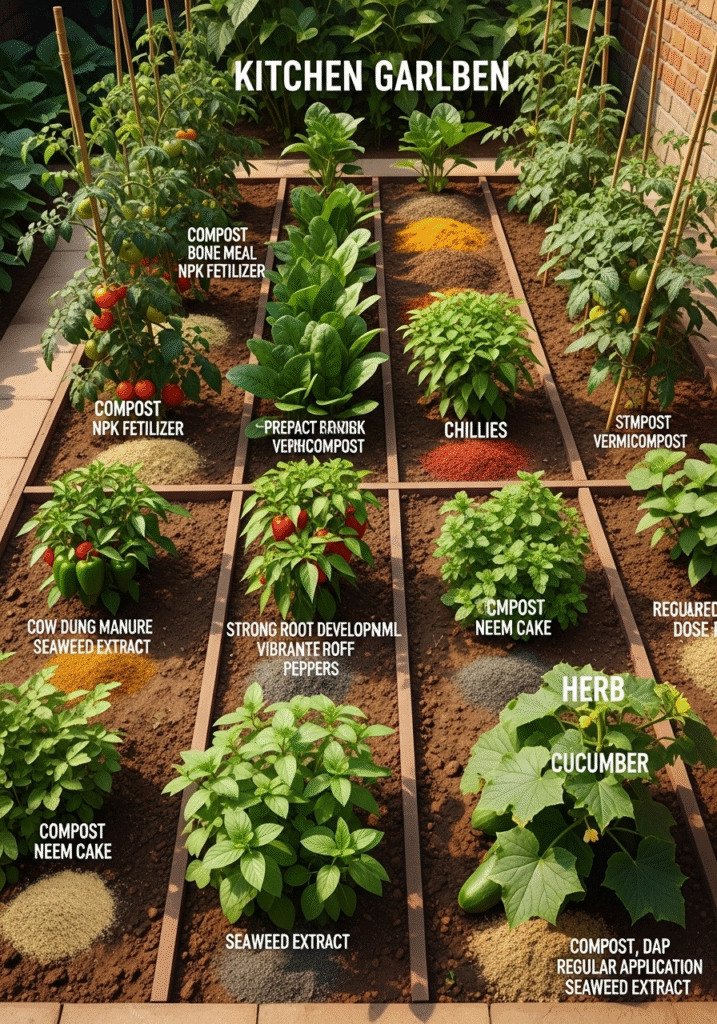
When and How to Apply Fertilizers
Knowing when and how to apply fertilizers is just as important as choosing the right type. Proper application techniques ensure that plants absorb nutrients efficiently, avoid nutrient burn, and grow strong and healthy. In kitchen gardening, where space is often limited and crops are closely planted, correct fertilization practices can significantly boost both yield and soil health. Here’s a complete guide to timing and techniques for applying fertilizers effectively:
Before Planting:
The first and most important step is preparing the soil. Before you sow seeds or transplant seedlings, mix well-decomposed compost, cow dung manure, or other organic matter directly into the top 6–8 inches of soil. This improves soil structure, increases moisture retention, and lays a nutrient-rich foundation for plant roots. For fruiting or flowering vegetables, you can also add slow-release organic fertilizers like bone meal or neem cake at this stage to encourage long-term nourishment.
During the Growing Season:
Once your plants are established, regular feeding is essential. Most kitchen garden crops benefit from being fed every 2–3 weeks. Use a top dressing method—sprinkling compost, vermicompost, or granular organic fertilizer around the plant base—or opt for liquid fertilizers like fish emulsion or seaweed extract for quicker nutrient absorption. Liquid fertilizers can be poured near the roots or used as foliar sprays depending on the plant’s needs. For synthetic options like NPK or micronutrient mixes, always follow the label instructions and avoid overfeeding, which can damage plant roots.
Foliar Application:
Some nutrients are best absorbed through the leaves, especially in the case of micronutrient deficiencies. Foliar spraying involves applying a diluted liquid fertilizer directly to the plant’s leaves using a spray bottle or garden sprayer. This method provides a quick boost, especially during flowering or fruit-setting stages. For best results, apply foliar sprays early in the morning or late in the afternoon, when sunlight is mild, to prevent leaf burn and ensure proper absorption.
Watering After Fertilization:
After applying dry or granular fertilizers, always water the area thoroughly. This helps dissolve the nutrients and carry them down to the root zone where they can be absorbed by the plant. Without watering, dry fertilizers may remain on the surface, leading to nutrient waste or even plant burn. For liquid fertilizers, if they are not diluted enough, a light watering afterward can also help prevent over-concentration at the root zone.
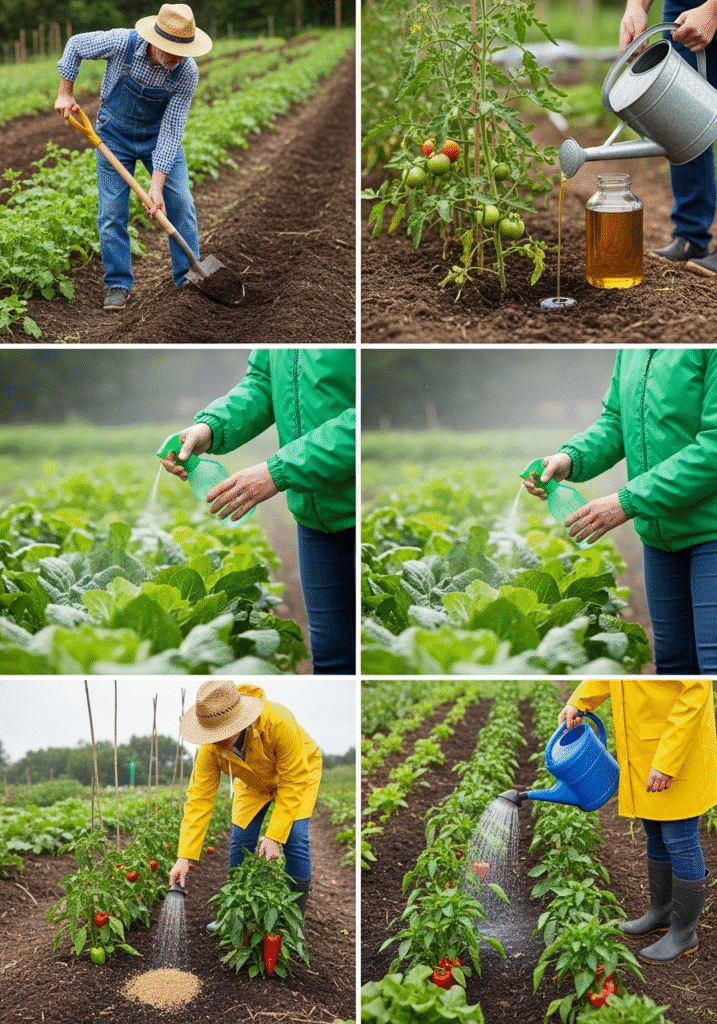
Tips for Choosing the Right Fertilizer
Selecting the right fertilizer is one of the most important steps in achieving a healthy, productive kitchen garden. With so many options available—organic, synthetic, granular, liquid—it can be overwhelming to decide what works best for your plants. The truth is, there’s no one-size-fits-all fertilizer. The ideal choice depends on your soil condition, the types of crops you’re growing, and your gardening goals. Here are some expert tips to help you choose the right fertilizer for your kitchen garden:
1. Test Your Soil (If Possible):
Before applying any fertilizer, it’s helpful to understand what your soil already has—and what it lacks. A simple soil test can reveal levels of nitrogen, phosphorus, potassium (NPK), pH, and micronutrients. This helps you make informed decisions and avoid wasting money on unnecessary fertilizers. Even without a test kit, signs like yellowing leaves or poor flowering can indicate specific deficiencies.
2. Use Organic Options for Long-Term Soil Health:
Organic fertilizers such as compost, vermicompost, cow dung manure, and neem cake not only feed plants but also improve soil quality over time. They encourage beneficial microbial activity, increase water retention, and reduce the risk of overfeeding. If you’re focused on sustainability or growing chemical-free food, organic fertilizers are the best choice for long-term garden health.
3. Combine Compost with Liquid Fertilizers for Balanced Nutrition:
A great strategy is to use compost as a base for enriching the soil and supplement it with liquid fertilizers like fish emulsion or seaweed extract during active growth periods. This approach provides both slow-release and quick-acting nutrients, ensuring steady growth and high productivity. It’s especially effective in container gardening or intensive small-space gardens.
4. Avoid Overfertilizing — More Is Not Always Better:
Too much fertilizer can harm your plants rather than help them. Overfertilization can lead to root burn, weak stems, excessive leaf growth, and even fewer flowers and fruits. Always follow the recommended dosage—whether you’re using organic or chemical products—and observe how your plants respond. It’s better to feed a little less and adjust gradually than to risk damaging your garden.
5. Choose Slow-Release Fertilizers for Busy Gardeners:
If you don’t have time for frequent fertilization, look for slow-release options. These fertilizers break down gradually, providing a steady nutrient supply over weeks or even months. Slow-release compost pellets, organic granules, and certain synthetic blends are perfect for gardeners who want low-maintenance care without compromising on plant health.
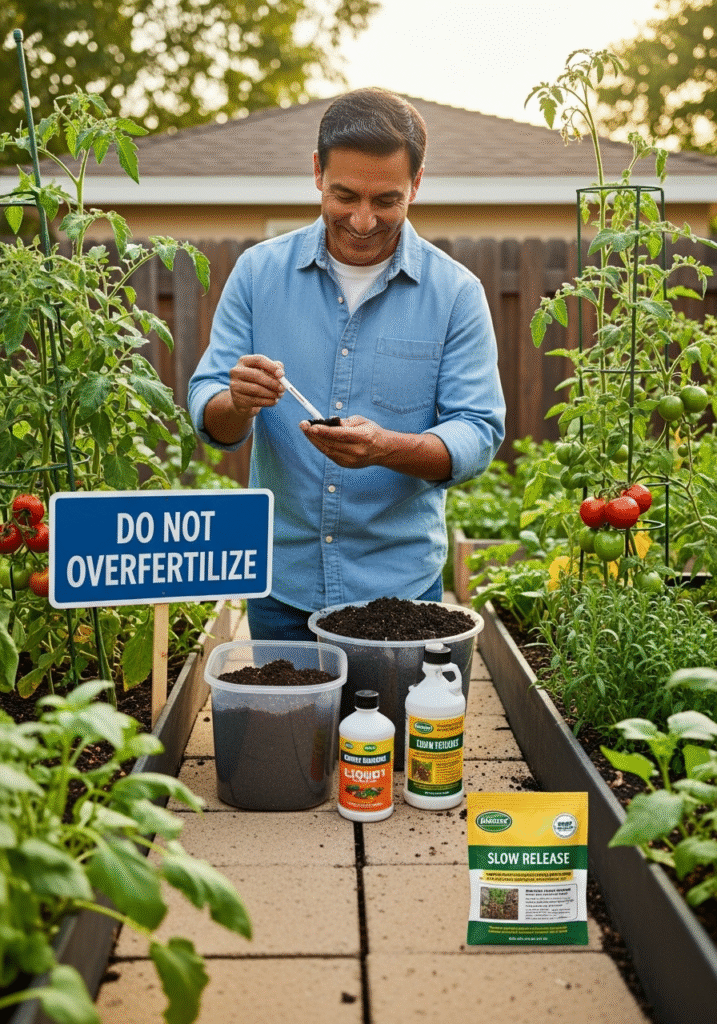
Common Mistakes to Avoid
Fertilizing your kitchen garden is essential for healthy plant growth, but it’s just as important to avoid the common mistakes that many home gardeners unknowingly make. Misusing fertilizers can result in more harm than good—leading to poor plant health, reduced yields, and long-term damage to your garden soil. Here are some of the most frequent fertilizer mistakes and how to prevent them for a successful and sustainable kitchen garden.
1. Using Too Much Fertilizer:
One of the most common errors is overfertilizing, especially with chemical fertilizers like urea or NPK. Gardeners often think that more fertilizer means faster growth—but that’s not true. Excess nutrients can burn plant roots, cause yellowing or curling of leaves, and lead to salt buildup in the soil. Over time, this disrupts the soil’s natural balance and kills beneficial microbes. Always follow the recommended dosage on fertilizer labels and observe your plants before increasing the amount.
2. Applying Fertilizer to Dry Soil:
Fertilizers, especially chemical types, should never be applied to dry soil. Doing so can result in severe root burn, as the concentrated nutrients absorb water from plant roots rather than supplying it. To avoid this, always water your plants before or after applying fertilizers—particularly granular or dry forms—to help dilute and distribute nutrients evenly.
3. Ignoring Nutrient Deficiencies:
Sometimes plants show visible signs of distress—yellowing leaves, stunted growth, or weak stems—but gardeners assume it’s due to pests or overwatering. In reality, these are often symptoms of nutrient deficiencies. Ignoring these signs can lead to poor flowering, low yields, and vulnerable plants. It’s essential to learn how to recognize the signs of nitrogen, phosphorus, potassium, and micronutrient shortages so you can apply the right corrective fertilizer in time.
4. Only Using One Type of Fertilizer:
Relying solely on one kind of fertilizer, whether organic or synthetic, can create nutrient imbalances in the soil. For example, using only nitrogen-rich urea can cause excessive leaf growth with little fruit or flower development. A better approach is to use a combination of base compost, slow-release organics, and occasional liquid fertilizers tailored to plant needs. Rotating between different fertilizers ensures balanced nutrition and supports a diverse, healthy soil ecosystem.
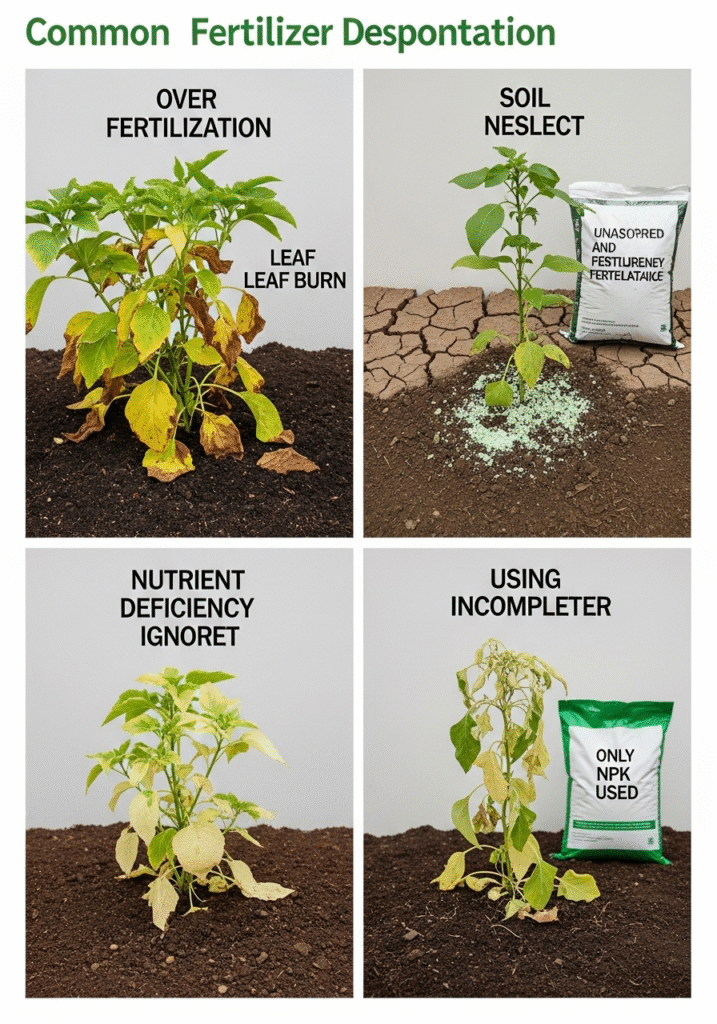
Conclusion
In conclusion, fertilizing your kitchen garden is not just a helpful gardening practice—it’s an essential part of growing healthy, vibrant, and productive plants. Whether you’re cultivating a few pots of herbs on your balcony or maintaining a full-fledged backyard garden, the proper use of fertilizers can dramatically improve plant growth, soil quality, and overall yield. From nutrient-rich organic options like compost, vermicompost, cow dung manure, and bone meal, to carefully measured chemical fertilizers like NPK blends and micronutrient mixes, each type plays a valuable role when used thoughtfully and responsibly.
The key to success lies in understanding your plants’ needs and feeding the soil—not just the plant. Healthy, well-nourished soil becomes a living ecosystem that supports root development, microbial activity, moisture retention, and disease resistance. By combining slow-release organics with occasional liquid feeds and addressing specific nutrient deficiencies with precision, you can create a balanced fertilizing routine tailored to your kitchen garden.
Also, timing and technique matter. Apply fertilizers at the right growth stages, water properly after application, and avoid common mistakes like overfeeding or using the wrong formulation. With consistency and care, even a small garden space can become a powerful source of fresh, flavorful, and chemical-free vegetables and herbs.
Ultimately, a well-fertilized garden not only brings you closer to nature but also supports a healthier lifestyle for you and your family. So invest in your soil, nourish your plants wisely, and enjoy the satisfaction of harvesting homegrown produce straight from your kitchen garden.
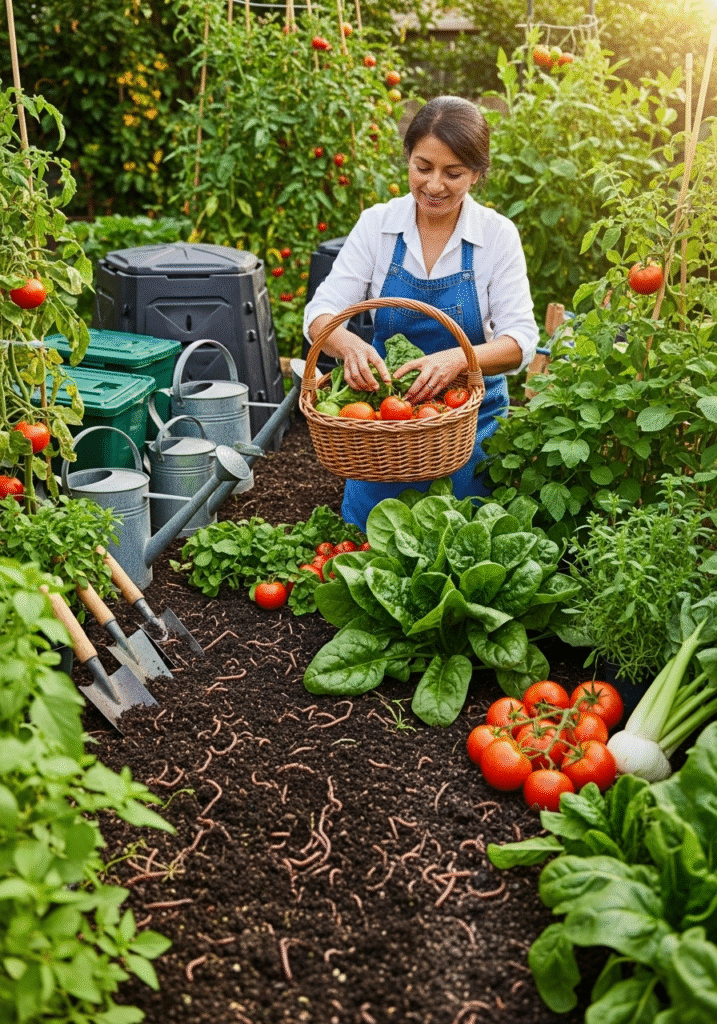

Pingback: Seasonal Flower Planting Guide: Best Blooms for Every Season (Beginner-Friendly Tips) - pademoluxury.com